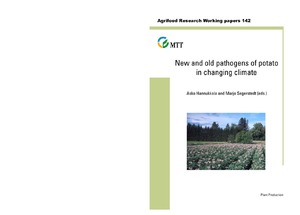Why have Colletotrichum and Helminthosporium become such a problem for fresh and ware potato quality - pathogen change or climate change
Tsror, Leah (Lahkim); Ben-Daniel, B.H; Erlich, Orly; Hazanovsky, Marina; Lebiush, S; Aharon, Menashe; Zig, Uri (2007)
Tsror, Leah (Lahkim)
Ben-Daniel, B.H
Erlich, Orly
Hazanovsky, Marina
Lebiush, S
Aharon, Menashe
Zig, Uri
Julkaisusarja
Agrifood Research Working papers
Numero
142
Sivut
s. 37
MTT
2007
Tiivistelmä
Both black dot and silver scurf caused by Colletotrichum coccodes and Helminthosporium solani, respectively, cause blemishes on the potato periderm. These diseases often occur together and frequently confused, cause reductions in fresh and ware potato production potential and damage value of seed potatoes. These diseases are largely distributed in all potato growing regions of the world, but black dot is most important in areas with dry and hot conditions, such as the Mediterranean regions, western USA, South Africa and southern Australia, although it is also well established in more temperate areas, such as UK, France, the Netherlands and Germany. Both diseases became a major problem in potato production over the past decade due to an increased demand for washed potatoes with a high-quality appearance. C. coccodes appears as a highly diverse species morphologically, physiologically and genetically; the existence of vegetative compatibility groups might explain this diversity, despite the fact that no sexual stage is known for the pathogen. C. coccodes is also diverse from a pathological point of view: it infects a range of plant species within and outside the Solanaceae, and shows some specific interactions with individual potato cultivars. In contrast, with H. solani there are no alternative hosts except to tuber-bearing Solanum species. Changes in cropping systems and in consumer dictate a reassessment of the economic importance of the skin blemish diseases, that severely affects the economic value of fresh market and seed potato production in regions of the world where external appearance is an essential driver of market access. An integrated disease management approach that includes cultural, biological and chemical control methods, in the field and in storage, is necessary for long-term control of skin blemish diseases. The fungicide TBZ was used for silver scurf control until the 1980 s, but due to high frequency of resistance imazalil has become the main fungicide used on seed tubers in Europe. However, C. coccodes is not sufficiently controlled by imazalil, suggesting another reason why black dot became a major pathogen on potato. Additional fungicides e.g. prochloraz, fludioxonil and azoxystrobin that control both pathogens are being introduced, however resistance to fludioxonil in H. solani was recently reported. Adequate control of the skin blemish diseases with very low tolerance for market access is highly problematic, and will require integrated strategies combining all currently available control methods.
Collections
- Julkaisut [87121]
